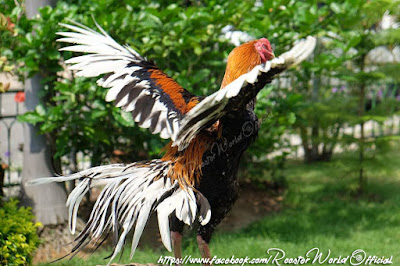The Indian fighting Roosters began in the first half of the
19th century in England. At least since the time of Henry VIII. Here enjoyed
cockfighting great popularity. English Game fowl breeders were proud of their
successful breeding lines. All the more it hit her that increasingly taps the
Asian type beat their victory usual taps. These animals were brought in the
rule of British soldiers from the Indian colonies. They came through the ports
of Plymouth and Falmouth into the country. For this reason, decided some
English breeders to combine the advantages of English and Asian Game fowl in a
new race. Here is particularly Sir Walter Raleigh Gilbert mentioned. He crossed
the English Black-Red Game with Asil. The F1 generation of this cross was mated
with Malays.
They are the ancestors of our Indian fighters, in addition to the English fighters, Asil and Malays. This crossover products were called by the English "Injees". Later this became "Indian game".However, there was a catch: The new breed was not suitable for cockfighting. The Roosters did not have enough fighting spirit and lacked agility and endurance. So the Indian Fighter is a fighting Rooster that has never competed in the cockfight arenas. Because of its striking appearance and its essence it has always had its adherents. However, the appearance of the Indian fighter of the late 19th century is little to compare with our present Indian fighters. It was more like a Malay.
They are the ancestors of our Indian fighters, in addition to the English fighters, Asil and Malays. This crossover products were called by the English "Injees". Later this became "Indian game".However, there was a catch: The new breed was not suitable for cockfighting. The Roosters did not have enough fighting spirit and lacked agility and endurance. So the Indian Fighter is a fighting Rooster that has never competed in the cockfight arenas. Because of its striking appearance and its essence it has always had its adherents. However, the appearance of the Indian fighter of the late 19th century is little to compare with our present Indian fighters. It was more like a Malay.
In 1896 the Indian Game Club established the standard for the new breed. This standard essentially corresponded already today. As color shock had only a dark (brown pheasant). In 1897 Henry Hunt 60 Years Anniversary of Coronation of Queen Victoria the color shock red-white (white-brown pheasant) ago. He called it Jubilee. Later the color varieties originated blue pheasant brown, white, yellow and America White Laced Red (white lined-red). This color variety is however not recognized in Germany.
The color varieties are almost exclusively pheasant brown and shown white-brown pheasant on German look. Blue-brown pheasant animals have unfortunately become increasingly rare in recent years, and pure white animals represent now a rarity. The yellow color shock was not to be seen for many years in major exhibitions. On the European Game fowl Show in Cologne 2008, some animals were shown for the first time. The result of the new breeding this color shock was quite good. It is hoped that the breeder continuing its work and we will see the yellow color impact of the Indian fighter in a few years back regularly for exhibitions.
Breeding Target
Breeding goal of the Indian fighter is a compact bulky
chicken in cube form. That is, the body should not be longer than wide and
taper sharply backwards. The wings are strong shouldered and are close to. In
the plan view of the hull has the classic heart shape. The back is short and
almost horizontal. The legs are set wide and the outside of the body. The wide
stance gives a vertical line from the wing above the legs to run. The legs
should be strong, round with strong toes and running Color intense yellow. The
head presents itself bulky and stocky and has a short, powerful, strong curved
beak. On his head sits a tight three-row pea comb.The wattles are recognizable
only in the beginning. The eye color is pearly, ie ivory. Never adult animals
may still show the orange eye of the young animals.
The rich lustrous plumage should be taut, hard and tight. When the taps a tight neck hackle is present.
The rich lustrous plumage should be taut, hard and tight. When the taps a tight neck hackle is present.
It is to wish the Indian fighter, that he finds for the
future more followers who have enough stamina to keep this breed long-term
loyalty. Because the problem of the Indian fighter is less to find a breeder to
keep as the breeder. Everyone who contributes to the idea to create this breed,
it is should be aware that he commits himself to a quite demanding and not
always frustrate free task. In the past, many breeders have underestimated this
task. Although they had begun with great vigor the breed, they have again a
"less problematic" after two to three years Breed dedicated. However,
no one should be put off, because one thing is certain you will be more than
compensated by the stunning, extraordinary nature of this race for all the
difficulties!


























